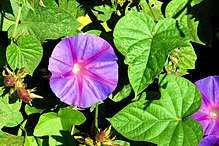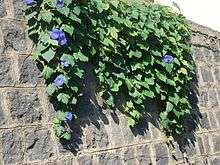Ipomoea indica
Ipomoea indica[3] is a species of flowering plant in the family Convolvulaceae, known by several common names, including blue morning glory, oceanblue morning glory, koali awa, and blue dawn flower. It bears heart-shaped or 3-lobed leaves and purple or blue funnel-shaped flowers 6–8 cm (2–3 in) in diameter, from spring to autumn.
| Ipomoea indica | |
|---|---|
 | |
| Scientific classification | |
| Kingdom: | Plantae |
| Clade: | Tracheophytes |
| Clade: | Angiosperms |
| Clade: | Eudicots |
| Clade: | Asterids |
| Order: | Solanales |
| Family: | Convolvulaceae |
| Genus: | Ipomoea |
| Species: | I. indica |
| Binomial name | |
| Ipomoea indica | |
| Synonyms | |
The Latin specific epithet indica means from India, or the East Indies or China.[4] In this case, the name likely refers to the West Indies, as I. indica is native to the New World. This plant has gained the Royal Horticultural Society's Award of Garden Merit.[5][6]
Description
Ipomoea indica is a vigorous tender perennial vine native to tropical habitats throughout the world that climbs well over other plants, walls and slopes as growing on the bottom. It is a twisting, occasionally lying, herbaceous plant which is more or less densely hairy on the axial parts with backward-looking trichomes. The stems can grow 3 to 6 cm long and sometimes have roots at the nodes.
The leaves are petiolate with 2 to 18 cm long petioles. The leaf blade is egg-shaped or round, 5 to 15 cm long and 3.5 to 14 cm wide. The underside is densely hairy with short, soft trichomes, the top is more or less sparsely hairy. The base is heart-shaped, the leaf margin is entire or three-lobed, the tip is pointed or sharply pointed.
The crown is funnel-shaped, 5 to 8 cm long, glabrous, bright blue or bluish purple, with age they become reddish purple or red. The centre of the crown is a little paler.
Inflorescence and fruit
The inflorescences are dense, umbelliform cymes from a few flowers. The inflorescence stems are 4 to 20 cm long. The bracts are linear or sometimes lanceolate. The flower stems are 2 to 5 (rarely up to 8 mm) long. The sepals are almost uniform, 1.4 to 2.2 cm long and slowly sharpened linearly. They are hairless to close-fitting, the outer three sepals are lanceolate to broadly lanceolate, and the inner two are narrowly lanceolate. The stamens and the stamp do not protrude beyond the crown. The ovary is hairless. The scar is three-lobed.
The fruits are more or less spherical capsules with a diameter of 1 to 1.3 cm. The seeds are about 5 mm in size.
Cultivation

It is a species widely cultivated as an ornamental plant for its popular colourful flowers, which has spread throughout the tropics and subtropics of the Old World. As it does not tolerate temperatures below 7 °C (45 °F), in temperate regions it is grown under glass.[7] It requires very light and nutrient-rich soil, which should be kept evenly moist.
Invasive species
It has become a noxious weed and invasive species in Australia, New Zealand, South Africa, California, Portugal[8] and New Caledonia.[9] It can grow as a separate plant if snapped during attempted removal process.
In New Zealand, it is classed as an unwanted organism under the Biosecurity Act 1993 and it is therefore illegal to sell, propagate and distribute the plant.[10] It is listed on the National Pest Plant Accord.
References
- USDA Plants Profile
- Aluka Species Profile
- "Ipomoea indica". Integrated Taxonomic Information System.
- Harrison, Lorraine (2012). RHS Latin for gardeners. United Kingdom: Mitchell Beazley. p. 224. ISBN 9781845337315.
- "RHS Plant Selector - Ipomoea indica". Retrieved 23 June 2013.
- "AGM Plants - Ornamental" (PDF). Royal Horticultural Society. July 2017. p. 53. Retrieved 12 March 2018.
- RHS A-Z encyclopedia of garden plants. United Kingdom: Dorling Kindersley. 2008. p. 1136. ISBN 1405332964.
- Plantas invasoras em Portugal (2013). Ipomoea indica. Available in http://invasoras.uc.pt/gallery/ipomoea-indica/. Accessed on 28 July 2013.
- Hequet, Vanessa (2009). Les espèces exotiques envahissantes de Nouvelle-Calédonie (PDF) (in French). p. 17.
- "Blue morning glory". Biosecurity New Zealand. 20 March 2009. Archived from the original on 27 May 2010. Retrieved 31 July 2010.
External links
![]()
- Hawaiian Ecosystems at Risk project (HEAR)
- Ipomoea indica in Topwalks
- Mitchell, B. (2004). Plant of the Month, June 2004: Ipomoea indica, University of St Andrews, Accessed 20 May 2007